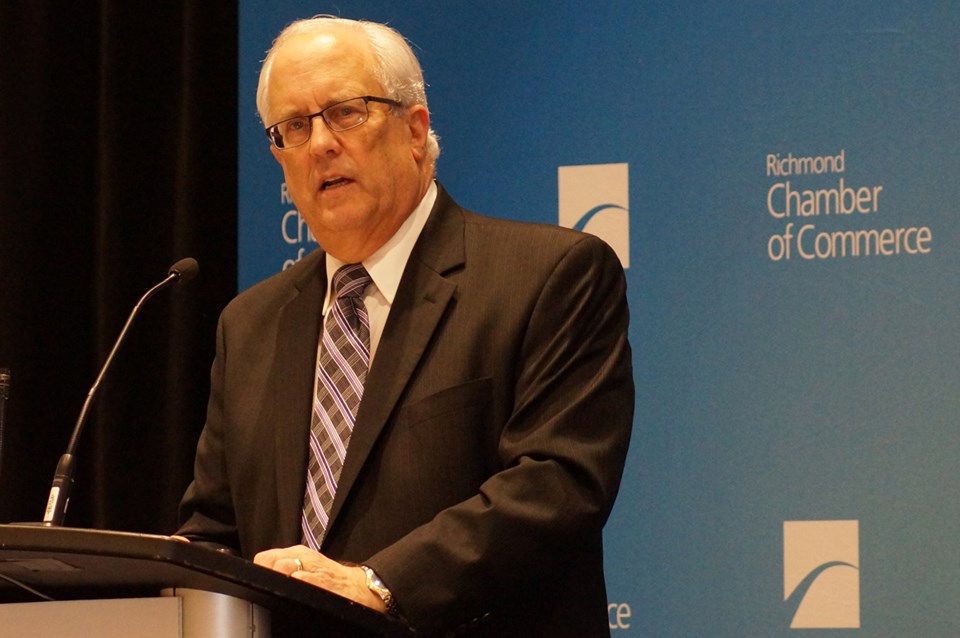Mayor Malcolm Brodie addressed controversial topics such as port activity, a proposed 10-lane bridge, mega homes and a police services review at a Richmond Chamber of Commerce hotel luncheon Friday afternoon, which doubled as the venue for his 2015 state-of-the-city speech.
Conversely, Brodie chose not to address other controversial issues in the city, namely real estate speculation and vacant homes. As well, the city’s handling of Chinese-only signs was left behind at the podium — although council’s decision to regulate “sign clutter” with an upcoming bylaw was addressed in his speech, on paper.
Brodie said the City of Richmond’s relationship with Port Metro Vancouver is one of the biggest challenges his government faces.
He cautioned, off script, that if the port remains unaccountable to the city, or even the province of B.C., Richmond farmland could soon be “wiped out.”
Brodie took to the ballroom’s projector screen to point out the scope of the 230-acre Gilmore Farms, recently purchased by the port for “future study.”
“If they can do this on one farm, why can’t they do this to an entire area. Why won’t east Richmond be wiped out and industrialized by the port?”
Brodie also took issue with the port’s governing structure and transparency.
“Is it right that a (PMV) board, made up of 13 unelected, unaccountable representatives of industry, mostly, who meet in a private room, are able to come into a city and say, ‘We need your agricultural land?’ I don’t think anything works that way,” said Brodie, noting the board has refused to meet with him.
Brodie defended his decision to support maintaining the existing George Massey Tunnel, while questioning the port’s involvement, behind closed doors, with the province.
“I say this knowing the Chamber has taken the position in favour of the bridge. But our city council looks at it through a bit more of a global point of view and we have a lot of questions that need answered,” said Brodie.
The stated reason from the Ministry of Transportation for the bridge is to ease congestion caused by regional growth (Richmond added 5,000-10,000 new vehicles to its roads in 2014, according to ICBC).
Brodie began his speech stating 2015 was a “remarkable time of growth” in Richmond.
The construction value of building permits issued in 2015 was $998 million, or 23 per cent more than the previous annual record, noted Brodie.
Most residential growth came in the multi-family sector, as Richmond added 2,209 of such units.
While none of those units were purpose-built rentals, Brodie stated Richmond has done well to focus on affordable housing for seniors and vulnerable, low-income residents.
Brodie pledged to “broaden the inventory of affordable housing options.”
He reminded his audience of the difficulties the city faced with large, new homes in neighbourhoods; last year the city lowered the maximum height of all new homes and terminated land-use contracts, bringing every residential property under city zoning regulations.
To accommodate growth, Brodie noted the city has built five new fire halls in the last decade, with a new Brighouse fire hall coming in 2017, next to a new $80 million Minoru pool and seniors centre, also under construction.
Brodie highlighted a number of parks and recreation initiatives for this year, such as the construction of a perimeter trail on the Garden City Lands, designing the (Fantasy) Gardens Agricultural Park and building Tait Riverfront Park in north Richmond.
In 2015 the city upgraded three new water pumps, and Brodie noted increased sport-hosting at the Oval, tourism and filming have contributed to the local economy.
During the event, Brodie asked chamber members to take an information package on a police services review. Each attendee also got two, free passes to the Richmond Olympic Experience, a new $10 million city-run museum at the Oval.



